Featured Comment
Made these on a charcoal grill and they turned out amazing! So much flavor and very easy prep.
★★★★★
– Ren
When you think of Japanese skewers, yakitori leads the pack, followed by pork yakiton, crunchy kushi katsu, warming oden, or maybe even grilled ayu fish. But beef kushiyaki? That’s the sleeper hit.
But beef kushiyaki brings sizzling beef skewers into the spotlight. Think of it as yakiniku on a stick. Quick, flavorful, and perfectly charred.

Beef Kushiyaki
Recipe Snapshot
- What is it? Japanese beef skewers with yakiniku-style marinade.
- Flavor profile: Savory, Smoky, Lightly sweet
- Why you’ll love this recipe: It’s the kind of recipe that impresses friends effortlessly. Juicy skewers, perfectly charred, and scalable for a crowd without losing flavor balance.
- Must-haves: Skewers, Beef steak, Grill or Broiler (Indoor or Outdoor)
- Skill Level: Easy
- Suitable for Meal Prep? Yes.
Summarize & Save this content on:
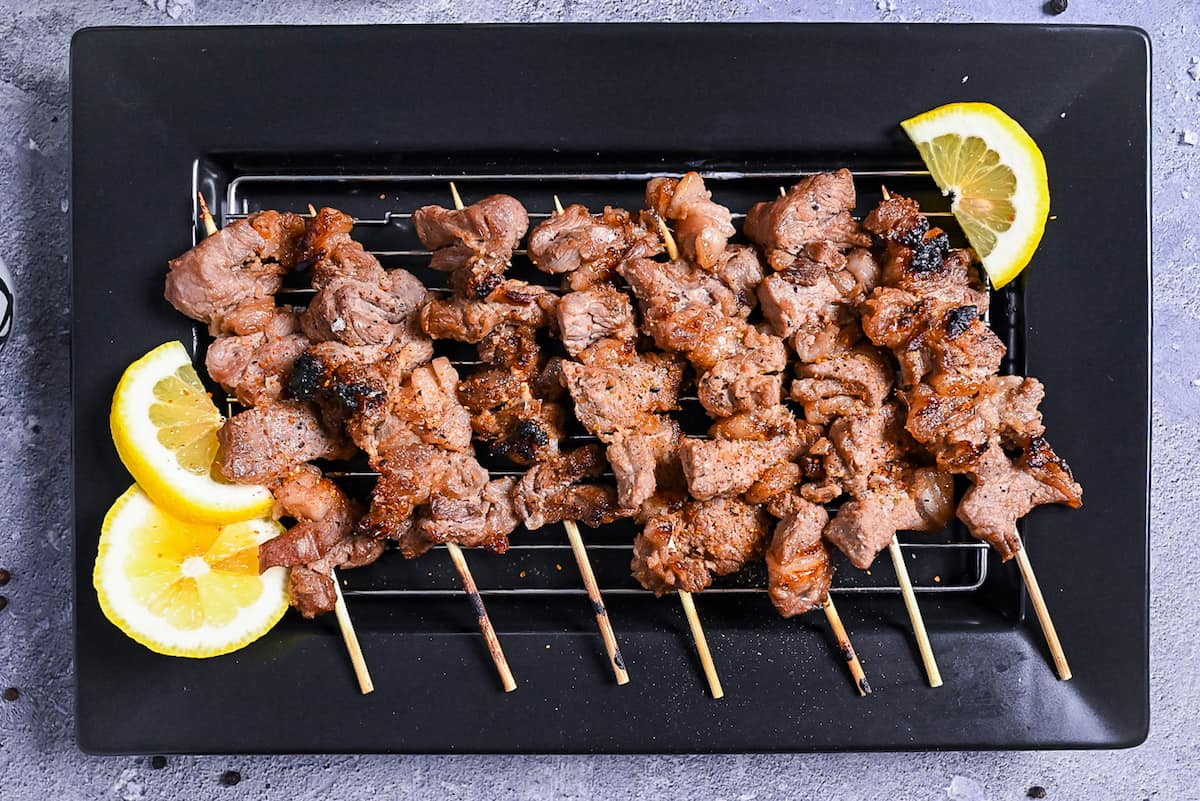
What is Beef Kushiyaki
Beef kushiyaki (牛肉の串焼き), or gyu-kushi, are Japanese-style skewers threaded with beef and sometimes a little fat for richness. Unlike yakitori, which is strictly chicken, kushiyaki covers any grilled skewer, making beef a popular and satisfying choice.
In this recipe, the beef gets a short soak in a fruity soy based marinade, then grilled or broiled until lightly charred. The result is tender meat with a savory-sweet glaze that feels special but still weeknight-doable.
If you want to know more about how Japanese people use beef, you could also check out classic Japanese beef recipes like beef udon and gyudon.
Japanese Beef Skewers Ingredients
What You’ll Need for Yakiniku Style Marinade
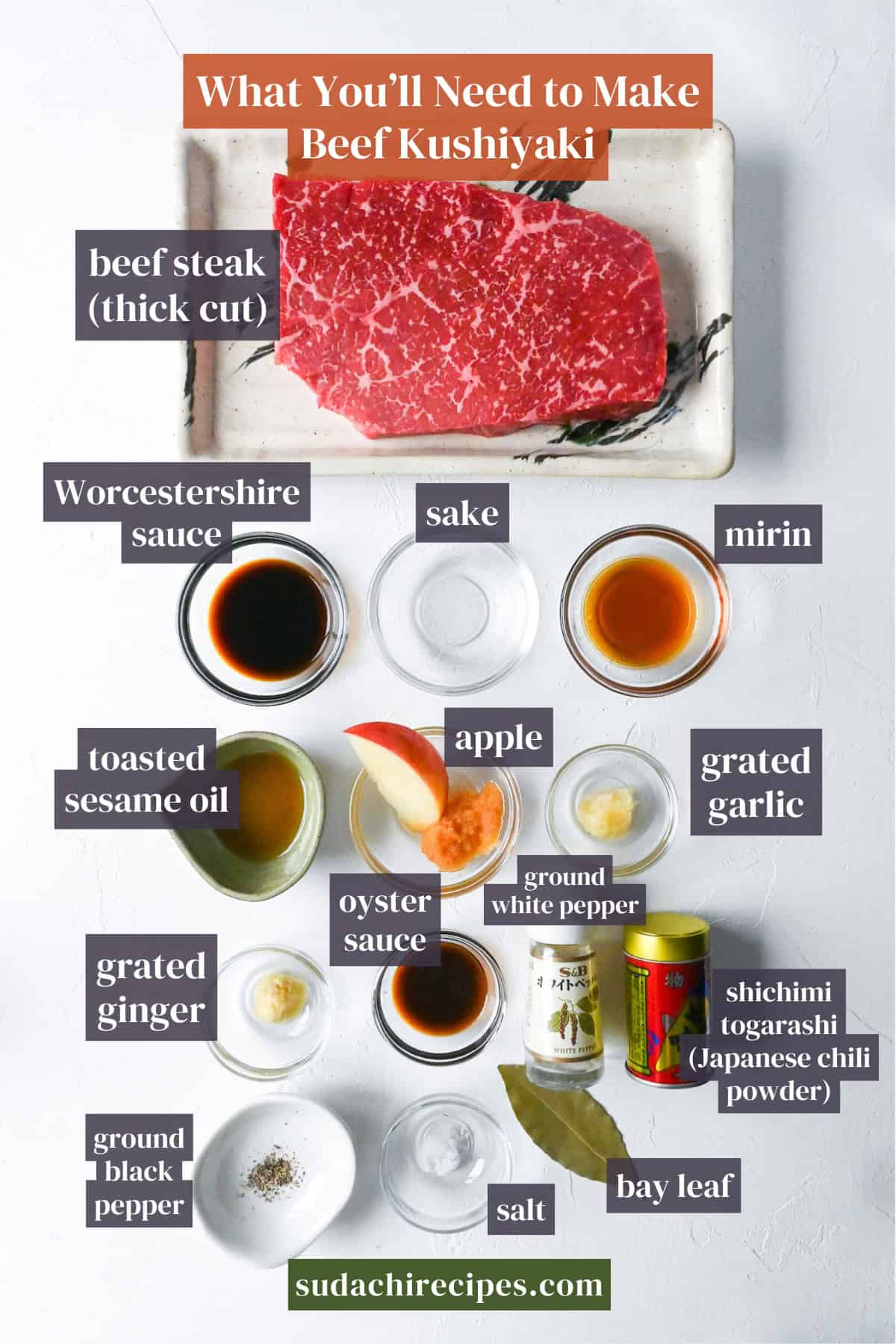
- Apple (grated): This brings gentle sweetness and a little juiciness that helps the beef brown and stay tender. You can grab any crisp variety (Fuji, Gala, Honeycrisp) from the produce aisle or a farmers’ market, and you’re set. No apple? Use pear for a similar tenderizing vibe.
- Worcestershire sauce: I used Japanese brands (like Kagome or Bull-Dog), but your standard Lea & Perrins will absolutely be fine too.
- Shichimi togarashi (Japanese seven-spice): This is a bright, peppery blend that adds a warm tingle and a little orange-zest aroma at the finish. Look for it at Asian groceries or online. No shichimi? A light dusting of cayenne pepper or red pepper flakes gives you that warming kick.
Recommended Beef Cuts
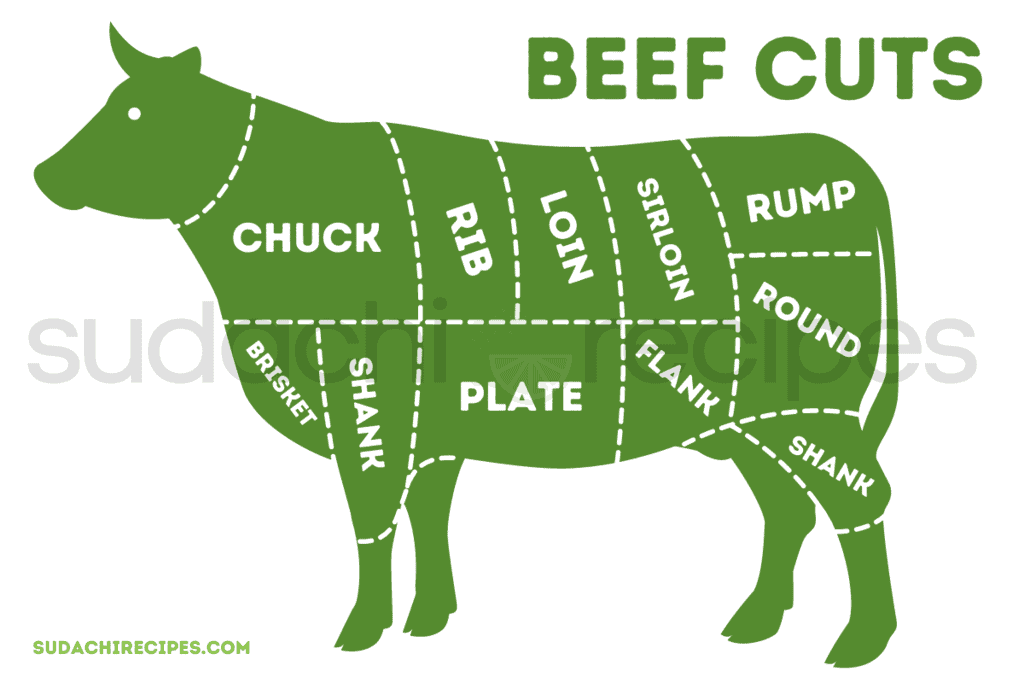
Use a thick steak you can cube for even grilling. Skirt steak (harami) is my top pick for deep beefiness and quick, juicy sear.
But any thick-cut steak from your local butcher works beautifully. The key is choosing something with good marbling that won’t dry out on the grill, like sirloin or even a well-priced chuck eye steak.
Substitution Ideas
- Sake alternatives: Dry sherry or white wine.
- Mirin alternatives: Mix your sake (or sherry) with a pinch of sugar for an instant substitute. In a real pinch, cola actually works too.
- Grated garlic & ginger: Slightly higher amount of store-bought pastes are perfectly fine here.
Have trouble finding Japanese ingredients? Check out my ultimate guide to Japanese ingredient substitutes!
How to Make My Beef Kushiyaki
If you prefer to watch the process in action, check out my YouTube video of this Japanese style beef skewers recipe!
i. Trim away any thick, waxy exterior fat, but save small pieces to thread between the meat for self-basting. Cut the steak into even 3 cm cubes (about 1¼ in).
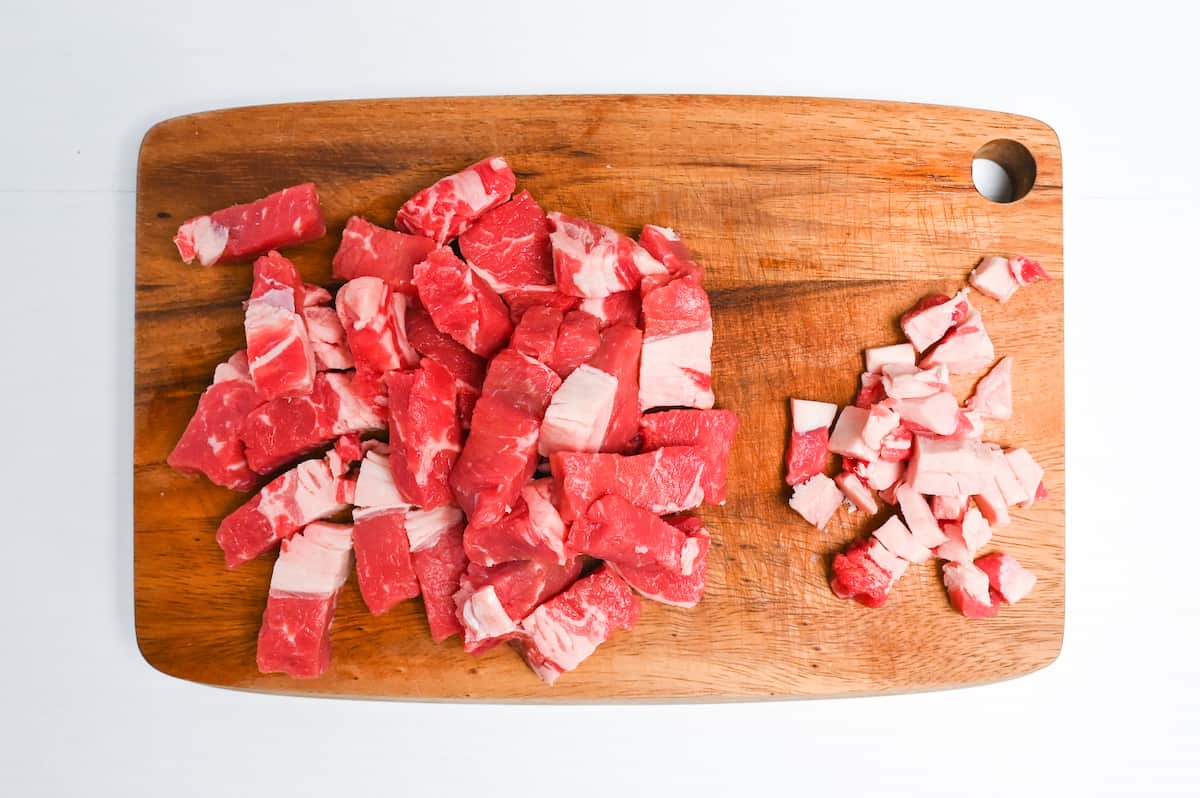
ii. Aim for uniform size so the skewers finish at the same time.
i. In a bag, combine sesame oil, a bay leaf, sake, mirin, white pepper, grated apple, sea salt, Worcestershire sauce, oyster sauce, grated garlic, and fresh ginger.
ii. Add the beef cubes and reserved fat, press out the air, and seal.

iii. Massage the bag until every cube is glossy, then refrigerate for 30 minutes. This short window seasons the exterior without tipping the salty components (oyster/Worcestershire/soy-derived flavors) into overkill.
Preheat a gas or charcoal grill to 230-260℃ (450-500°F), or set the broiler to high. Clean and oil the grates just before cooking so the first sear is confident and nonstick.
If using charcoal, set a two-zone fire so you can move skewers away from flare-ups caused by the sugars in the marinade.
Skewer beef and small fat pieces alternately, packing pieces snugly but not jammed so heat can circulate. For bamboo, soak sticks 20-30 minutes or use flat metal skewers to avoid scorching. Plan 4-5 pieces of beef per skewer for even cooking and easy serving.
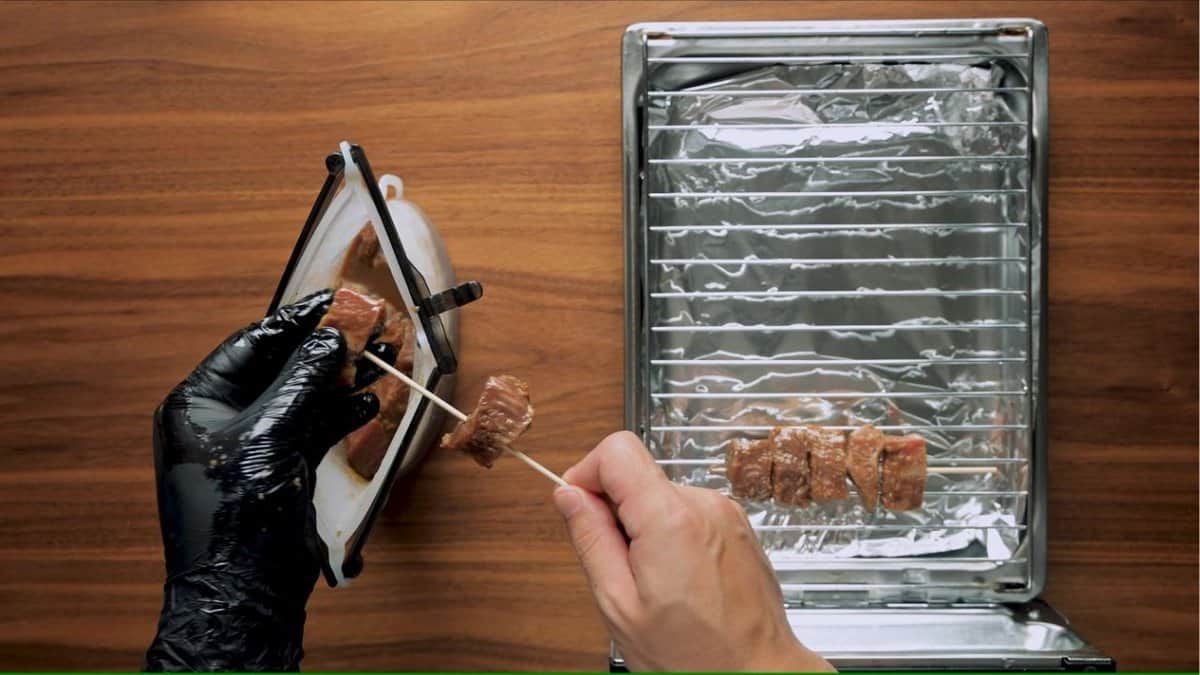
i. Lay the skewers on the hot grate and season only the exposed top with a pinch of coarse salt and black pepper. Don’t move them for 4-5 minutes. Listen for an active sizzle and watch for browned edges and light beads of fat.
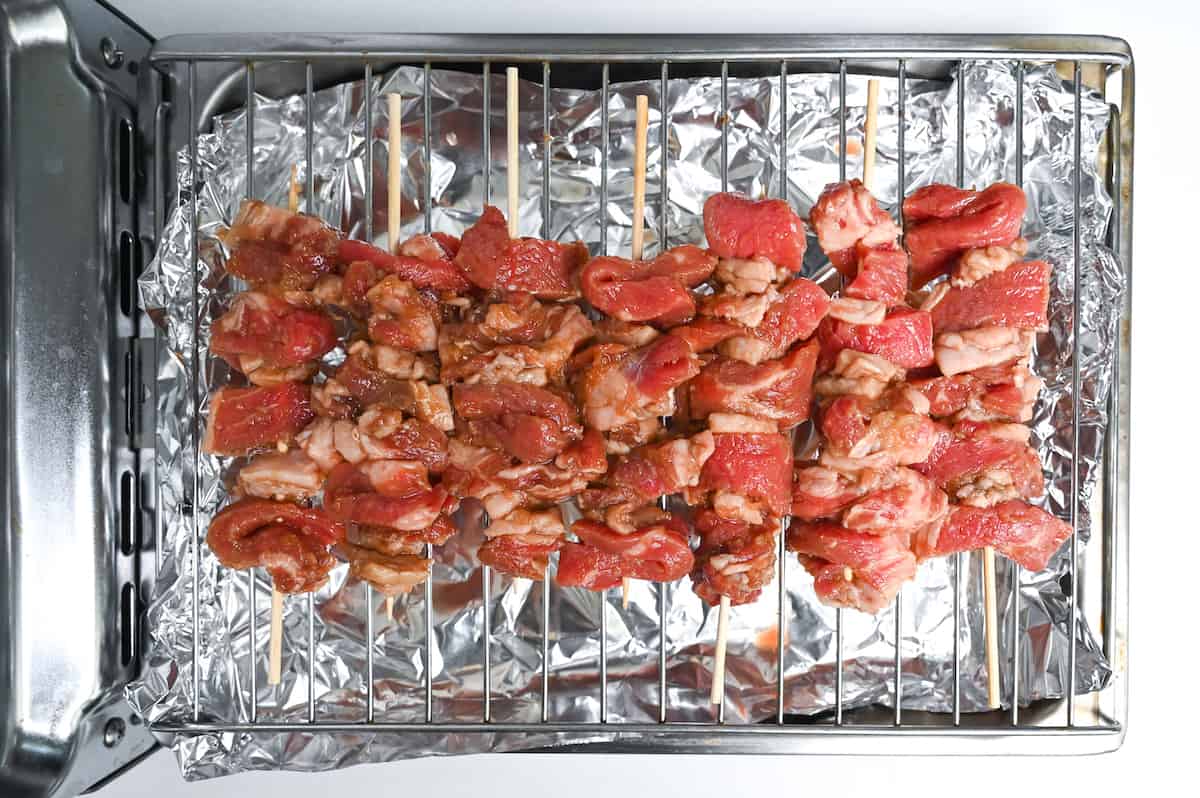
ii. Flip the skewers, sprinkle the now-top side with another small pinch of salt and pepper, and cook 3-4 minutes more.
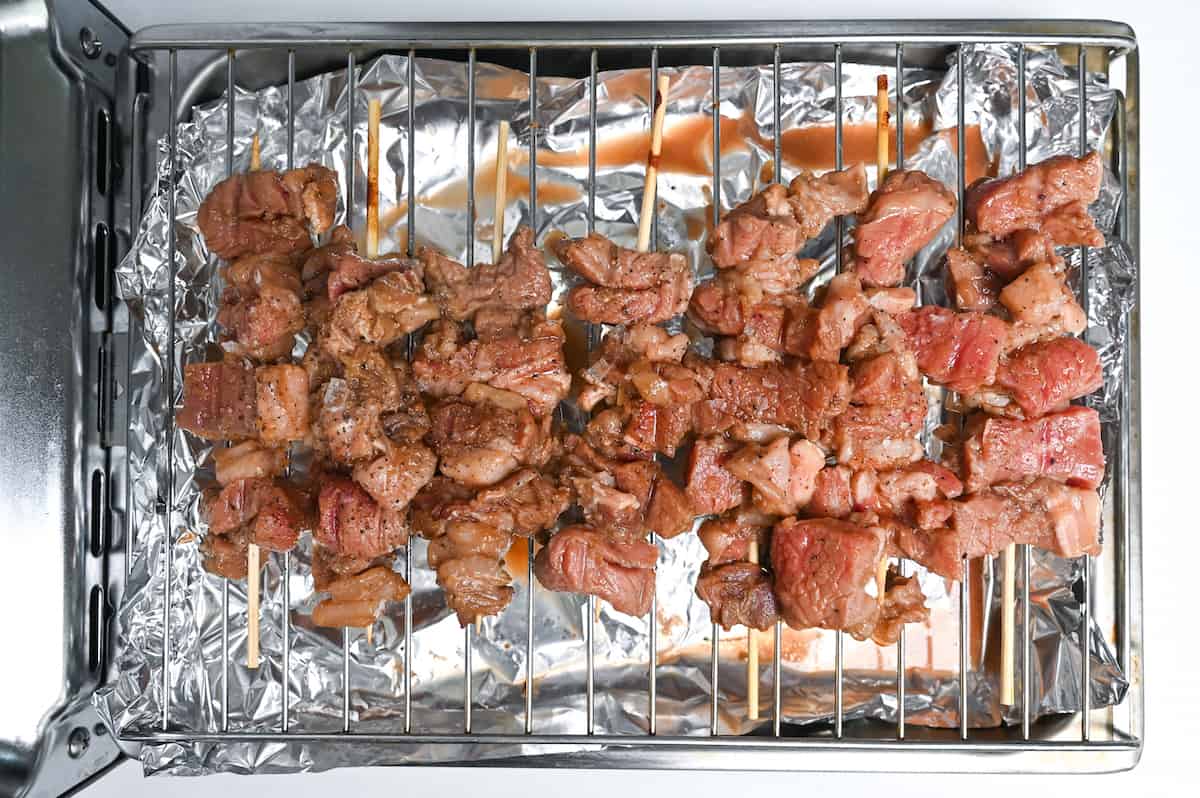
i. Finish with a sprinkle of shichimi togarashi for heat and a bright squeeze of lemon to balance the marinade’s sweetness. Serve hot off the rack.
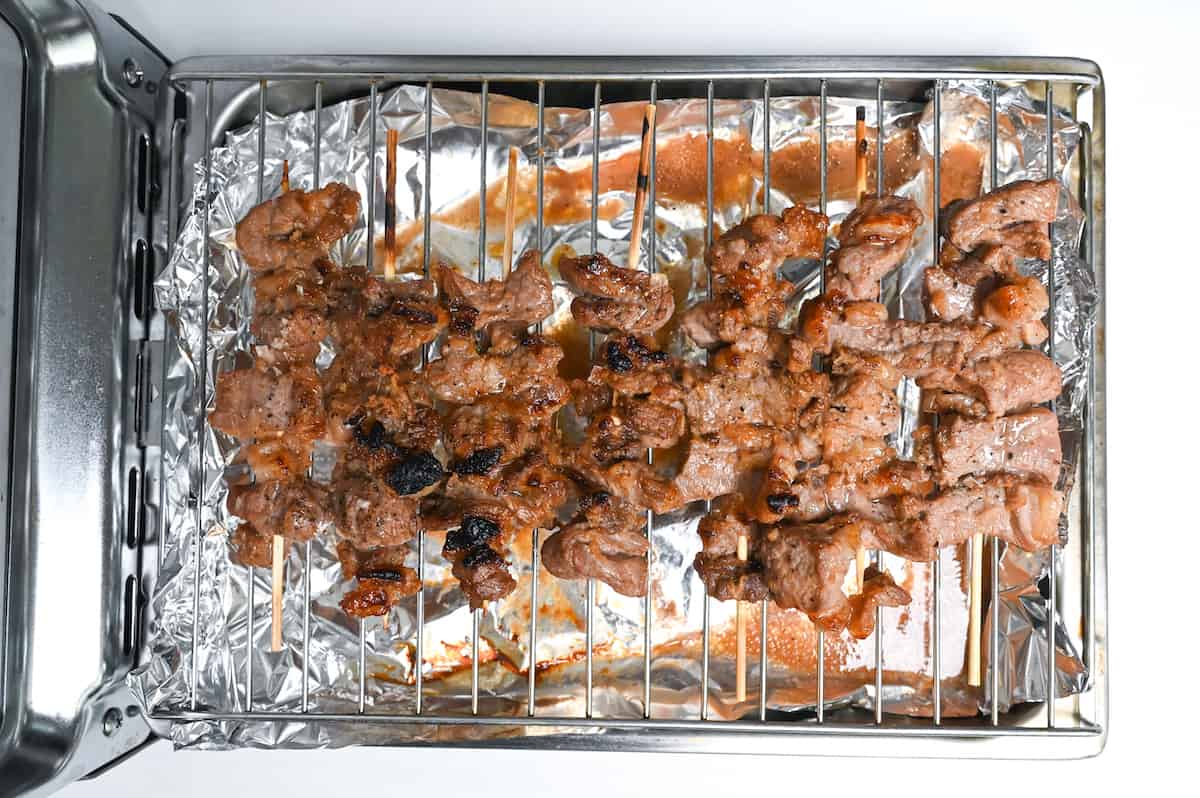

Essential Tips & Tricks
- Cut beef into even 3 cm (1¼ in) cubes so all pieces cook at the same pace and stay juicy.
- Keep marination short (about 30 minutes).
- Preheat the grill or broiler fully before cooking.
- If you use steak with fat cap, thread small pieces of fat between the beef cubes.
- Season only the exposed side with salt before each flip.
With these simple tips in mind, you’re set for success every time you make Japanese beef skewers.
Storage & Meal Prep
Fridge: Store cooked beef skewers in an airtight container in the refrigerator for 1-2 days. The beef will gradually lose its tender texture.
Freezer: Not recommended.
Meal Prep: You can marinate the raw beef up to 2 hours ahead and refrigerate it covered.
Reheating: If you must reheat leftover kushiyaki, use a skillet over medium-low heat for 1-2 minutes per side.
What to Serve With This Recipe
Kushiyaki Q&A
There’s no exact record of when beef kushiyaki began, but it likely evolved from yakitori (chicken skewers) by applying the same grilling method to beef. Today it’s popular in beef-producing regions like Yonezawa and Hida, and you’ll also find it at izakaya and yakitori shops. Seasonings vary: tare (sweet-savory sauce) is common, while salt and pepper highlight premium Wagyu, and richer sauces are often used for offal (horumon) or budget cuts.
Not at all. While many Japanese restaurants feature Wagyu for kushiyaki, home cooking doesn’t require it, especially if you’re marinating the meat. Regular steak cuts such as Angus or Aussie beef work beautifully, delivering tenderness and rich flavor at a fraction of the cost. Save Wagyu for when you want to enjoy its delicate taste with beef sukiyaki.
Kushiyaki is the broad term for anything grilled on skewers. Kushi means “skewer” and yaki means “grill.” It covers chicken, beef, pork, seafood, and vegetables alike. Yakitori, however, refers specifically to chicken skewers. That said, regional variations blur the definition. In Kagoshima and Miyazaki, chicken thigh may be butterflied and grilled over a net instead of skewered, while in Imabari (Ehime), chicken is grilled directly on a griddle.

More Japanese Appetizers
- Agedashi Tofu (Japanese Deep Fried Tofu)
- Crispy Japanese Fried Chicken
- Izakaya Style Salted Cabbage (Yamitsuki Cabbage)
- Chicken Tsukune (Japanese Glazed Meatballs)
Craving something delicious but short on time? These easy Japanese appetizers will satisfy your taste buds without the hassle!
Did You Try This Recipe?
I would love to hear your thoughts!
💬 Leave a review and ⭐️ rating in the comments below. 📷 I also love to see your photos – submit them here!
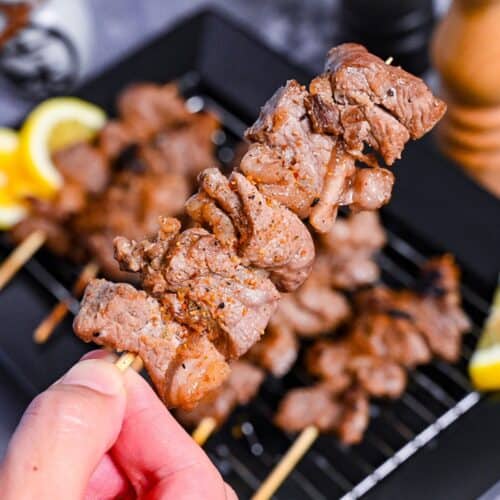
Japanese Beef Skewers (Beef Kushiyaki)
Equipment
Ingredients
- 300 g beef steak skirt, sirloin, ribeye, or strip, avoid very lean cuts
- 1 tbsp Worcestershire sauce Japanese or British brands
- 1 tbsp sake or dry sherry, white wine
- 1 tbsp mirin or sake + sugar, cola
- 1 tbsp grated apple or grated pear
- ½ tbsp toasted sesame oil
- 1 tsp oyster sauce
- 1 tsp grated garlic or store-bought paste
- 1 bay leaf
- ½ tsp grated ginger root or store-bought paste
- ¼ tsp salt for marinade
- ⅛ tsp ground white pepper
- sea salt for sprinkling
- ground black pepper
- Japanese chili powder (shichimi togarashi) or cayenne pepper
- lemon juice
My recommended brands of ingredients and seasonings can be found in my Japanese pantry guide.
Can’t find certain Japanese ingredients? See my substitution guide here.
Instructions
- Take 300 g beef steak and cut off the fatty part. Cut the meat into 3cm square pieces (1¼ inches) and the fat into small cubes.

- Place the cubes of beef and fat in a bag and add 1 tbsp Worcestershire sauce, 1 tbsp sake, 1 tbsp mirin, 1 tbsp grated apple, ½ tbsp toasted sesame oil, 1 tsp oyster sauce, 1 tsp grated garlic, 1 bay leaf, ½ tsp grated ginger root, ¼ tsp salt, and ⅛ tsp ground white pepper. Massage until all the seasonings are evenly distributed and the meat is fully covered, then marinate in the fridge for at least 30 minutes.

- Preheat a grill or broiler on medium-high for 5-10 minutes. While you wait, push the beef onto skewers alternating between the meat and fat. Place the skewers onto a wire rack with foil underneath. Sprinkle with a pinch of sea salt and ground black pepper and place under the grill for 5 minutes.

- Turn the skewers over and season with another pinch of salt and pepper, then grill for 4 minutes.

- Once cooked through and slightly charred, remove from the grill and rest for a few minutes.

- Sprinkle with a pinch of Japanese chili powder (shichimi togarashi) and a squeeze of lemon juice. Enjoy!

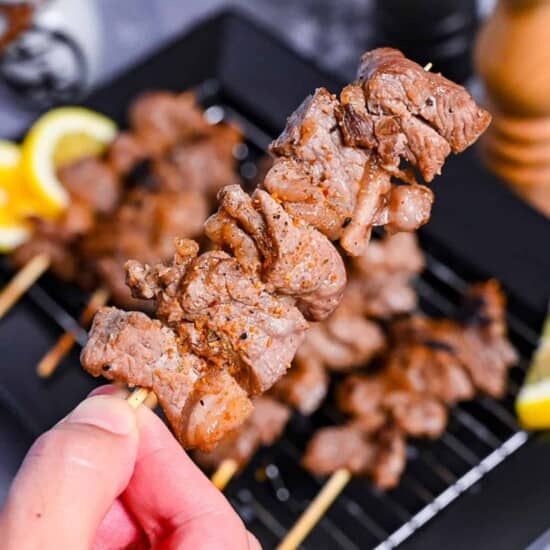




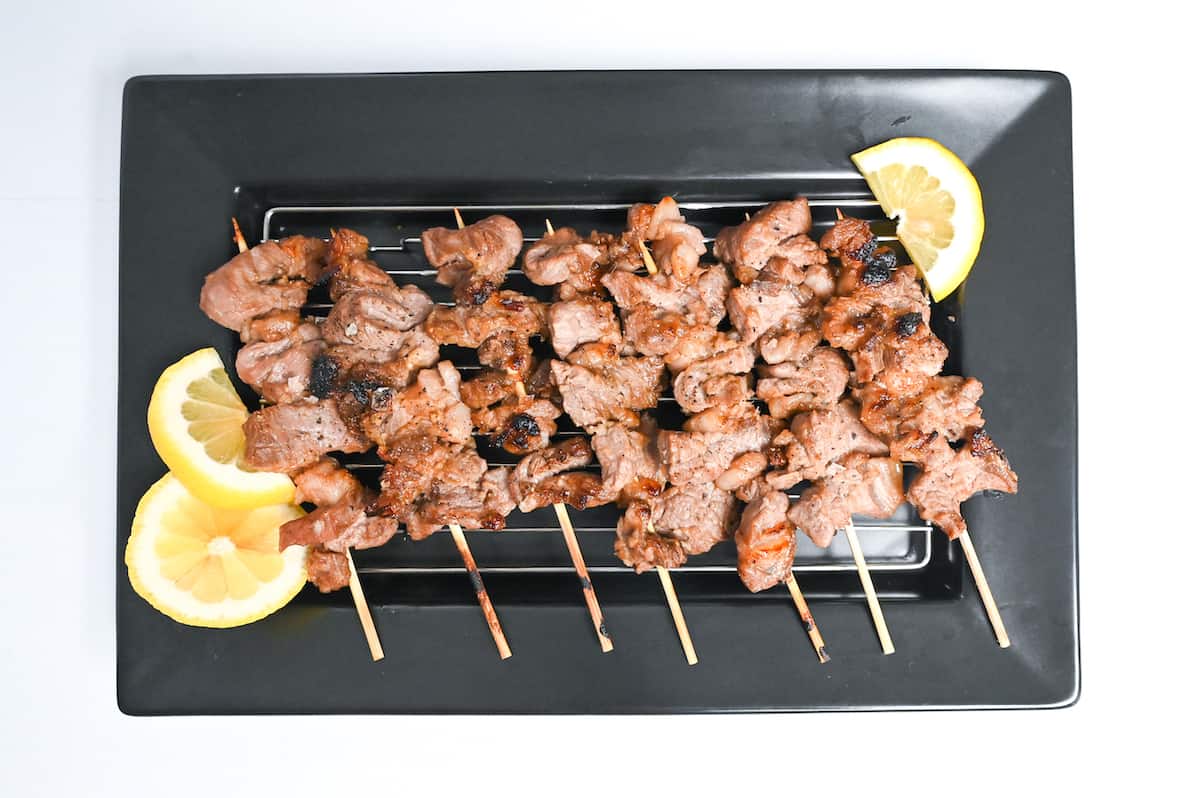
thank you for such a special recipe. we enjoyed making and eating it. the taste of the sauce made the meat out of the ordinary.
Hi Hadas,
Thank you so much! I’m glad you all liked the sauce! 🙂
Yuto
Made these on a charcoal grill and they turned out amazing! So much flavor and very easy prep.
Hi Ren,
Thank you for trying this recipe! That’s really the best way to do it. I’m a little jealous of that charcoal flavor! So glad you enjoyed it. 🙂
Yuto